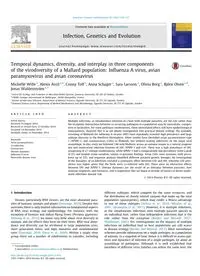
2015 Temporal dynamics, diversity, and interplay in three components of the virodiversity of a Mallard population_ Influ PDF
Preview 2015 Temporal dynamics, diversity, and interplay in three components of the virodiversity of a Mallard population_ Influ
Temporal dynamics, diversity, and interplay in three components of the virodiversity of a Mallard population: Influenza A virus, avian paramyxovirus and avian coronavirus Michelle Wille a, Alexis Avril a,b, Conny Tolf a, Anna Schager a, Sara Larsson a, Olivia Borg a, Björn Olsen c,d, Jonas Waldenström a,⇑ a Centre for Ecology and Evolution in Microbial Model Systems, Linnaeus University, SE-391 82 Kalmar, Sweden b CIRAD, Campus international de Baillarguet, 34398 Montpellier, France c Section of Infectious Diseases, Department of Medical Sciences, Uppsala University, SE-751 85 Uppsala, Sweden d Zoonosis Science Centre, Department of Medical Biochemistry and Microbiology, Uppsala University, SE-751 85 Uppsala, Sweden a r t i c l e i n f o Article history: Received 14 August 2014 Received in revised form 23 October 2014 Accepted 14 November 2014 Available online 21 November 2014 Keywords: Avian paramyxovirus Co-infection Coronavirus Disease dynamics Influenza A virus Newcastle disease virus a b s t r a c t Multiple infections, or simultaneous infection of a host with multiple parasites, are the rule rather than the exception. Interactions between co-occurring pathogens in a population may be mutualistic, compet- itive or facilitative. For some pathogen combinations, these interrelated effects will have epidemiological consequences; however this is as yet poorly incorporated into practical disease ecology. For example, screening of Mallards for influenza A viruses (IAV) have repeatedly revealed high prevalence and large subtype diversity in the Northern Hemisphere. Other studies have identified avian paramyxovirus type 1 (APMV-1) and coronaviruses (CoVs) in Mallards, but without making inferences on the larger viral assemblage. In this study we followed 144 wild Mallards across an autumn season in a natural stopover site and constructed infection histories of IAV, APMV-1 and CoV. There was a high prevalence of IAV, comprising of 27 subtype combinations, while APMV-1 had a comparatively low prevalence (with a peak of 2%) and limited strain variation, similar to previous findings. Avian CoVs were common, with preva- lence up to 12%, and sequence analysis identified different putative genetic lineages. An investigation of the dynamics of co-infections revealed a synergistic effect between CoV and IAV, whereby CoV prev- alence was higher given that the birds were co-infected with IAV. There were no interactive effects between IAV and APMV-1. Disease dynamics are the result of an interplay between parasites, host immune responses, and resources; and is imperative that we begin to include all factors to better under- stand infectious disease risk. � 2014 Elsevier B.V. All rights reserved. 1. Introduction Viruses, particularly RNA viruses, are the most abundant para- sites of humans, animals and plants (Domingo, 2010). Despite this assertion, there is only limited information on fundamental aspects of RNA virus ecology and epidemiology. For instance, with the exception of humans and Indian Flying Foxes (Pteropus giganteus; Anthony et al., 2013), we know very little about viral diversity in animals, and the effects they have on their hosts. RNA viral abun- dance and diversity can be attributed to large population sizes, short generation times, and high mutation and recombination rates (Domingo, 2010; Elena et al., 2000). Within a single virus group there are a number of subdivisions to consider, including different subtypes, which compete for the same resources, and the distribution of closely related variants that make up the viral population (quasispecies), which may confer a fitness advantage to one of these subtypes (Arbiza et al., 2010; Miralles et al., 2001; Ojosnegros et al., 2011). However, it is multiple infections, or the simultaneous infections with multiple parasite species in an individual host, rather than independent infections that is the rule rather than the exception (Bordes and Morand, 2011; Woolhouse, 2002). Yet, investigations on the impacts of multiple infections on individual host or host populations are still scarce in disease ecology (Bordes and Morand, 2011). Most surveillance schemes provide information on a single pathogen, in a population of animals, in a snapshot of time. Hence it is difficult to assess pat- terns and dynamics of infection of a single pathogen, let alone an assemblage of pathogens. Although it is well established that members of different virus families can utilize the same host, the http://dx.doi.org/10.1016/j.meegid.2014.11.014 1567-1348/� 2014 Elsevier B.V. All rights reserved. ⇑ Corresponding author. E-mail address:
